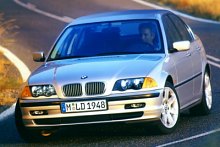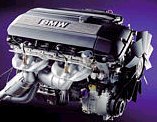 To
car enthusiasts all over the world, the launch of a new BMW compact
saloon
is always a big news. Since the 02 series invented this category of
cars
in 1967, every BMW compact saloons were highly praised about their
dynamics,
no matter engine or handling. The first 3 series succeeded to bring
higher
performance by its 6 cylinder engine. The second generation diverted to
more choices including 4 doors, convertible and touring. The third
generation,
also the most successful one, raised dynamics to even higher level
while
provides quality matching Mercedes-Benz. After 8 years, everyone is
waiting
for the fourth generation with high expectation. To
car enthusiasts all over the world, the launch of a new BMW compact
saloon
is always a big news. Since the 02 series invented this category of
cars
in 1967, every BMW compact saloons were highly praised about their
dynamics,
no matter engine or handling. The first 3 series succeeded to bring
higher
performance by its 6 cylinder engine. The second generation diverted to
more choices including 4 doors, convertible and touring. The third
generation,
also the most successful one, raised dynamics to even higher level
while
provides quality matching Mercedes-Benz. After 8 years, everyone is
waiting
for the fourth generation with high expectation. As usual, the new 3 series grows in every dimensions - 25mm in wheelbase and 38mm in width free up the originally cramped cabin. Now 6 feet passengers can rest comfortably in the rear seats, with sufficient of knee room as well as shoulder room. It is still not class-leading when compare with Peugeot 406 and Volkswagen Passat, but easily beat its most likely rivals - Alfa Romeo 156 and Audi A4. This could be a crucial advantage. Another improvement is the refinement. Since its predecessor was virtually unbeatable in dynamics (some may say Alfa 156 overtook it in the last minute, but I don't agree.), BMW made most effort in upgrading refinement and quality. Open the door, you will find a very classy interior just like a downsize 5 series. Turn on the engine and you will discover that its engines become a lot more flexible that you need not to work too hard to access the same performance. Its ride is the most improved aspect. While preserving high level of stability, the suspensions (still MacPherson and Z-axle, but with different spring / damping rate and aluminium arms) become as supple as the 5 series. You wouldn't believe a car in this class and this size could ride so comfortable.
Handling enhancement might be less noticeable. Due to improved sound insulation and supple ride, you may subjectively feel less exciting than before. In fact, the new 3 corners more stable, with less body roll due to the stronger chassis and wider track, which grew 63 and 57mm in front and rear respectively. Anyway, its cornering ability remains unmatchable. On demand, power slide is still accessible in this rear-driven saloon, although normally it is extremely secure. Steering remains very communicative. As a whole, the
new BMW 3
series becomes far more refined and comfortable than ever, but remains
as exciting as before. It might not be as driver-biased as before, but
still manage to cope with Alfa 156. In my opinion, the Alfa can steal
some
sales by its 2.0 twin spark version, since it is cheaper and faster
than
318i. However, Alfa V6 can hardly compete with 328i. Without
compromising
with cost problem, the 328i has the best engine and the necessary power
to make itself a perfect car. |
| The above report was last updated in 1998. All Rights Reserved. |
 Although
the previous 3 was virtually perfect in engine and handling, the new 3
still improves a little, if not huge. The grass-root engine is
basically
the previous 1.9 litres sohc unit with variable intake manifold, but
now
added with twin balancer shafts to reduce NVH. It becomes as smooth as
a six cylinder. Those real 6 pots engines also received improvement -
Double
Vanos variable valve timing now extends service to the exhaust valves,
thus leads to a broad torque curve and brings the peak torque earlier,
from 3950 rpm to 3500 rpm. "Smooth, responsive" and "the best six
cylinder
in the world" were what I described the previous engine. The new
engines
are even better.
Although
the previous 3 was virtually perfect in engine and handling, the new 3
still improves a little, if not huge. The grass-root engine is
basically
the previous 1.9 litres sohc unit with variable intake manifold, but
now
added with twin balancer shafts to reduce NVH. It becomes as smooth as
a six cylinder. Those real 6 pots engines also received improvement -
Double
Vanos variable valve timing now extends service to the exhaust valves,
thus leads to a broad torque curve and brings the peak torque earlier,
from 3950 rpm to 3500 rpm. "Smooth, responsive" and "the best six
cylinder
in the world" were what I described the previous engine. The new
engines
are even better.  While
there are super saloons like Audi S4, BMW M5 etc. with real performance
but look so ordinary, the same companies also sell fake coupes having
the
same underpinning as saloons. BMW 3-Series Coupe is one of them. You
pay
more for it in order to get less doors, less head room and less
visibility.
What a ridiculous. Undoubtedly, there are people who want a more
purposeful,
more handsome shape than the ordinary 3-Series, but then the BMW Coupe
doesn’t look too much differ from the saloon, unlike Peugeot’s 406
Coupe.
While
there are super saloons like Audi S4, BMW M5 etc. with real performance
but look so ordinary, the same companies also sell fake coupes having
the
same underpinning as saloons. BMW 3-Series Coupe is one of them. You
pay
more for it in order to get less doors, less head room and less
visibility.
What a ridiculous. Undoubtedly, there are people who want a more
purposeful,
more handsome shape than the ordinary 3-Series, but then the BMW Coupe
doesn’t look too much differ from the saloon, unlike Peugeot’s 406
Coupe.
 Basically, the
M54 is derived
from the 2.8-litre predecessor, with stroke increased to 89.6 mm.
Versus
the bore of 84 mm, it seems to be a torque-bias powerplant. However, it
is amazing that the maximum power has gained a massive 38 hp out of a
mere
186 c.c. extra displacement. In other words, the specific output has
been
raised from 69.1 to 77.5 hp / litre, this implies more changes than
increased
stroke had been done. BMW said the extra c.c. contributed to 11.6
horsepower,
with the remaining mainly come from improved breathing and exhaust,
plus
a bit from increased valve overlap of the re-calibrated Double Vanos
variable
valve timing. As a result, the 330i and 330Ci now tops an untouchable
155
mph, and more remarkable is the acceleration: 0-60 now takes just 6.2
seconds,
that’s quicker than many sports cars ! No wonder Autocar’s Peter
Robinson
called it "Junior M3".
Basically, the
M54 is derived
from the 2.8-litre predecessor, with stroke increased to 89.6 mm.
Versus
the bore of 84 mm, it seems to be a torque-bias powerplant. However, it
is amazing that the maximum power has gained a massive 38 hp out of a
mere
186 c.c. extra displacement. In other words, the specific output has
been
raised from 69.1 to 77.5 hp / litre, this implies more changes than
increased
stroke had been done. BMW said the extra c.c. contributed to 11.6
horsepower,
with the remaining mainly come from improved breathing and exhaust,
plus
a bit from increased valve overlap of the re-calibrated Double Vanos
variable
valve timing. As a result, the 330i and 330Ci now tops an untouchable
155
mph, and more remarkable is the acceleration: 0-60 now takes just 6.2
seconds,
that’s quicker than many sports cars ! No wonder Autocar’s Peter
Robinson
called it "Junior M3".  4-wheel-drive
sedans are not very popular in Europe, but American buys a lot of Audi
and Subaru equipped with full-time 4WD. That calls for BMW’s re-enter
the
4WD sedan market with the 330xi. Yes, it’s "xi" instead of "ix", the
latter
appeared since the E30 325ix but disappeared in recent years. However,
the new 4WD system is derived from the X5 SUV rather than the previous
ix.
4-wheel-drive
sedans are not very popular in Europe, but American buys a lot of Audi
and Subaru equipped with full-time 4WD. That calls for BMW’s re-enter
the
4WD sedan market with the 330xi. Yes, it’s "xi" instead of "ix", the
latter
appeared since the E30 325ix but disappeared in recent years. However,
the new 4WD system is derived from the X5 SUV rather than the previous
ix.